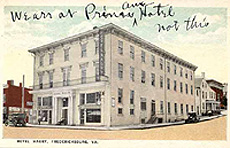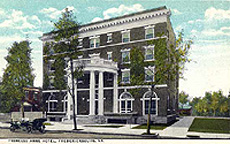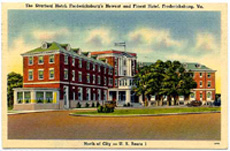By Barbara Crookshanks
Today, Fredericksburg ponders the building of a single downtown hotel, but during the 19th century, Fredericksburg was known as a town of hotels.
Some were large and elegant. Some catered to specific clienteles. All left their mark on Fredericksburg’s history.
Most people traveling from Washington to points south stopped over in Fredericksburg. So did those who were on their way to the Virginia springs.
The travelers were a varied lot, ranging from congressmen and planters and their families, to “sporting men” and members of circus troupes. A president of the United States signed one hotel register and the president of the Republic of Texas another.
Local residents also made good use of the facilities. The hotels were the scene of many a party, ball, and theatrical performance. The area’s practical jokers made one hotel their headquarters.
Historians Robert Howison, writing in 1880, and Capt. S.J. Quinn, writing in 1908, recorded older townspeople’s memories of these hostelries. In the 1970s, historian Robert A. Hodge wrote a detailed history of one of them—the Exchange Hotel.
Fires ended the stories of at least four of the downtown hotels—the Indian Queen, the Farmers', the Rappahannock House (later the Shakespeare), and the first Exchange, the only one to be rebuilt as a hotel.
Indian Queen
Members of Congress and other travelers going to and from Washington relaxed on the porch of the Indian Queen. The porch, with colonnade, extended the entire length of the building, which was on the south corner of Caroline and Charlotte streets, near the current proposed site of a hotel envisioned by developer Tommy Mitchell.
A local newspaper, the Virginia Herald, reported once that a 100-pound sea turtle was being prepared in the Indian Queen’s kitchen.
The Indian Queen, according to Capt. Quinn, was “a fine old building erected probably in colonial times.” The first proprietor was Jacob Herndon; the last was a Mr. Whiting. Its lot extended to Princess Anne Street, with stage yard and stables.
One evening, no less a personage than John Randolph of Roanoke arrived at the Indian Queen. The congressman from Virginia, described as “elegant, sarcastic, and eccentric,” was known for his defense of states’ rights. What’s more, he had fought a duel with Henry Clay. (Fortunately, neither gentleman was injured.)
The Democrats congregated to invite Randolph to share a bowl of punch. He replied: “I don’t drink with strangers and if I can’t rest here one night without being disturbed by a mob, I will drive to the Sycamores [an inn on the Bowling Green Road].”
Another punch bowl—this time the Indian Queen’s washtub—fared much better. Robert Howison wrote of the evening “choice spirits” from the Chotank region of King George County held “a special carouse.” The convivial bunch filled the washtub with choice liquors and a pair of well-worn leather boots. No one was the worse for the experience.
The end to such revels came when the Indian Queen burned to the ground in a midday fire in May of 1832. It was never rebuilt.
Farmers’ Hotel
 The Farmers’ Hotel, on the west corner of Caroline and Hanover streets extending up Hanover to Jail (or Hay Scales) Alley, was called the leading hotel of the town in its day.
The Farmers’ Hotel, on the west corner of Caroline and Hanover streets extending up Hanover to Jail (or Hay Scales) Alley, was called the leading hotel of the town in its day.
Both stage lines—“Extra Billy” Smith’s and Col. Porter’s—had their headquarters at the Farmers’. “Extra Billy,” later a Confederate general and a governor of Virginia, got his nickname while in the stage business.
According to Capt. Quinn, Billy was blessed with “unsurpassing politeness” and was always ready to put on as many extra stages as needed—thus his name “Extra Billy,” which he carried to his grave.
Dabney Herndon Maury, Fredericksburg native and another Confederate general, recalled: “In the summer season ten coaches at once would drive from that old Tavern [the Farmers’ Hotel] to the White Sulphur. It was said that one team of thoroughbred sorrels made Chancellor’s Tavern, ten miles away, in one hour.”
There was high excitement on Caroline Street on March 17, 1842, when the stagecoach carrying author Charles Dickens pulled up in front of the Farmers’ Hotel. On his American tour, Dickens had traveled from Potomac Creek to Fredericksburg, a harrowing journey through what he called “a series of alternate swamps and gravel pits.”
Ten-year-old Moncure Daniel Conway of Falmouth was determined to see the famous author. The schoolboy jumped out of an open window—7 or 8 feet from the ground—at Thomas Hanson’s Fredericksburg Classical and Mathematical Academy located in the north wing of old City Hall.
Young Conway, who would also become a noted author, arrived at the Farmers’ just as Dickens was alighting from the stage. Master Conway thought the flogging he received on his return to school worth the privilege of getting a good look at “the greatest man in the world.”
Dickens and party lunched at the Farmers’, but hopefully didn’t meet members of the original Jaw Bone Club. The sitting room of the Farmers’ was the meeting place for these jokers of the 1830s and 1840s. “Their object,” wrote Howison, “was to extract as much enjoyment as possible from any suitable objects for practical jokes.”
They sent a naïve gentleman on a roundabout search for the “Corporation Gun” to kill mad dogs. One member specialized in loading cigars with gunpowder.
After the main part of the Farmers’ Hotel burned many years before Capt. Quinn’s day, E.G. “Peck” Heflin built the large brick Enterprise Building on the site about 1900. The lower part had a store and post office; the upper floors had a public hall, sleeping apartments and offices.
The Exchange Hotels
The original three-story Exchange Hotel, on the south corner of Caroline and Hanover streets, had front walls of pressed brick, oil-finished and of a beautiful red. The brickwork of the entire building was said to be the most handsome in the state.
Historian Robert A. Hodge researched its long history. Built by William D. Green about 1837, it had a theatrical hall known as Green’s Assembly. Artist John A. Elder, who became noted for his portraits and Civil War paintings, had his studio in the first Exchange.
A fire on Dec. 18, 1857, destroyed the first Exchange Hotel. Foundations were laid for rebuilding but all work stopped when the Civil War broke out. Less than a year after the end of the war, the remains of the Exchange barely escaped condemnation and rebuilding continued.
On Nov. 21, 22 and 23, 1866, the public was invited to view the handsome new hotel and enjoy festive suppers. They also enjoyed the tableaux given for the benefit of the Ladies’ Memorial Association of Fredericksburg, which was beginning its task of reinterring the Confederate dead. Maj. Horace Lacy’s presentation of “The Conquered Banner” was a highlight of the evening.
When the new Exchange Hotel opened officially on Jan. 1, 1867, the newspaper described it as “having all the appearance and appointment of a city establishment.” There was a stone porch, ballroom, dining room, and a graceful, circular walnut staircase. Its many chimneys were an integral part of the Fredericksburg skyline.
In the lobby was an “unsurpassed” business directory with two large rosewood frames divided into squares listing all area businessmen. In the center of one frame was a clock around which was shown the hours of departure and arrival of the trains. In the center of the other frame was a picture of the steamer Wenonah at sea. Machinery kept her wheels and the waves around her in motion. Arrival and departure of steamboats were shown.
Things went well for the second Exchange Hotel for a short while. Trees and flowers filled a handsome little garden. On Monday nights during the summer of 1868, weather permitting, the brass band of professor Andrew B. Bowering performed from the hotel’s balcony.
But by 1879, the Exchange was in dire financial straits. Fredericksburg businessman John G. Hurkamp and others bought it for a rumored $6,000. Maj. C.B. Luck leased the property and advertised that it had been thoroughly renovated and refinished with the latest style of furniture including woven wire springs and hair mattresses.
Next came L. Cotton and William A. Hill, two gentlemen from Connecticut, who took possession of the Exchange on Jan. 1, 1887, and completed renovations early in 1892. A Free Lance reporter pronounced the parlor “a gem” and the dining room the finest in the South.
The 20th century was not kind to the Exchange, with major competition from the new Princess Anne and Stratford hotels. By 1915, the Exchange had become the Hotel Frederick and then, in 1921, the Hotel Maury.
In the mid-1980s, the building was restored by the Shibley Ehman Co. and today has luxury apartments on the upper floors and businesses on the street level.
Planters’ Hotel
The 3 1/2-story Planters’ Hotel building still stands at the corner of Charles and William streets. The brick exterior has been covered with stucco, but traces of its past elegance remain.
President-elect Lincoln checked in at the Planters’ on Dec. 18, 1860, after the presidential election.* Soon the hotel’s guest register would be filled with the names of former U.S. Army officers heading to their homes in the South.
During the Civil War, the hotel was managed by Councillor Cole and a short time after the war by a Mr. Mitzell. Since then, it has not been kept as a hotel.
At the beginning of the 20th century, the Planters’ Hotel building became the office and salesroom of R.T. Knox and Brother, producer of extract from the sumac tree. The building later became the Knoxanna Apartments. Today, the offices of a mortgage firm are on the first floor; the basement is a popular restaurant.
Liberty Hotel
Sam Houston, who sometimes dressed in Indian attire, was a frequent guest at the Liberty Hotel. According to Capt. Quinn, the Liberty was headquarters for “the sporting men” and a stopping place for quite a number of the leading men of the South.
The colorful Houston’s arrivals must have been greatly anticipated for he had commanded the army that won the independence of Texas from Mexico. “Six Feet Six Sam,” as he was called, also was twice president of the Republic of Texas, governor of two states—Tennessee and Texas—and senator from Texas.
The Liberty Hotel on Liberty Street was a Colonial-style structure in the style of Mary Washington House. Liberty Street was then on the outskirts of Fredericksburg in what was known as Wagon Town. Here, farmers brought their goods from the Orange and Culpeper areas.
Traveller’s Rest
Traveller’s Rest, on the south corner of Caroline and Frederick streets, was headquarters for all circuses and menageries.
Laboring men came here after work. So did the ward politicians who, Capt. Quinn wrote, “laid schemes to carry elections.” He called Traveller’s Rest “a tavern of considerable notoriety and popularity.”
The tavern was destroyed—how, we are not told—some years before the Civil War, and the lot remained vacant for nearly 60 years.
Thomas Curtis’ Hotel and Oyster House
Local politicians also congregated at Thomas Curtis’ Hotel and Oyster House. It was known as “The Tammany Hall of Fredericksburg.” Here, they discussed the merits of candidates and determined their success or defeat. Located on Caroline Street near the present Antique Court of Shops, it was destroyed during the December 1862 shelling of the town in the Civil War.
The Alhambra
Just below the Exchange on Caroline Street was the venerable Alhambra, named for the castle of the Moorish kings in Grenada, Spain. One of its later proprietors, John W. Allison Jr., changed its name to Alsonia. By 1908, it had become a restaurant.
Rappahannock House
Thomas Goodwin kept the Rappahannock House, later the Shakespeare, on the east side of Caroline St. about halfway between George and Hanover streets. It burned down after the Civil War and storehouses were built on its site.
Eagle Hotel
A favorite stop for both farmers and stagecoach passengers was the Eagle Hotel, just above the Exchange Hotel on Hanover Street By 1908, it had been refitted for families and room-renters and called the Eagle Flats. The building has been demolished.
Then and Now
When Capt. Quinn published his History of the City of Fredericksburg, Virginia in 1908, he deplored that railroads and steamboats had brought about the decline of many of the old hotels: “Travellers found floating palaces and moving cafes. They look not for the hotels in small towns.”
The next 90-plus years brought changes Quinn may not have envisioned. Steamboat travel would disappear; railroad travel would gradually decline. The automobile was king—so much so that motorists traveling U.S. 1 would crowd Fredericksburg streets.
Hotels prospered once more—especially the elegant Princess Anne and the Stratford (later the General Washington Inn). Things turned around again as motels clustered on the fringes of the Interstate 95.
Today, with the upsurge of interest in things quaint and historic, the hotel in a small town may be coming into its own once more.
Editor's notes:
This article was originally published in The Free Lance-Star on July 29, 2005. It is reprinted here with both the author's and the newspaper's permissions.
*There is debate among historians as to whether Lincoln's signature in the register is genuine.
The images used to illustrate old hotels in the article are part of LibraryPoint.org's postcard collection. However, the Knox Building (Planters' Hotel) photo first appeared in Ronald Shibley's Historic Fredericksburg: A Pictorial History.





